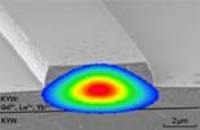In the University of Twente, Prof. Markus Pollnau and his colleagues, who belong to the MESA+ Institute for Nanotechnology, have created an optical amplifier doped with rare earth ion.

It is difficult to amplify the optical signals in the applications of photonics. Semiconductor optical waveguide amplifiers undergo the effects of temporal and spatial gain pattering, but the gain will be high per unit length of approximately 1000 dB/cm.
Ex3+ doped fiber amplifiers unite good overall gain with small non-linearities and lower noise, but these are expensive due to the usage of fiber for more distances and become incompatible for on-chip applications.
The MESA+ researchers were capable of enhancing the waveguide amplifiers’, which is doped with rare earth ion and the modal gain per unit length is increased to around 1000 dB/cm. This enhancement was possible by engineering the geometry, concentration of the dopant, and the host material.
KLu(WO4)2, KGd(WO4)2 and KY(WO4)2, which is in the monoclinic potassium double tungstates family, are utilized in the approach. These materials doped with Yb3+ ions have some high transition side views found in dielectric materials.
The newly developed rare-earth-ion-doped amplifiers may allow propagation without loss in plasmonic nanostructures, and may possibly give optical gain in nanotechnology devices like nanolasers and nanoamplifiers. They can be used as on-chip amplifiers for transmitting data in high-bit-rate at approximately 1 ìm of signal wavelengths.